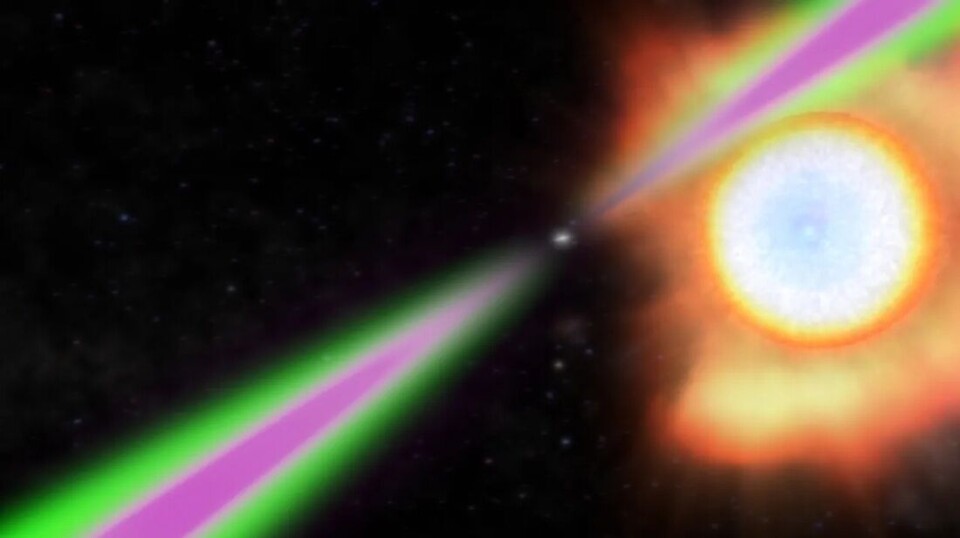THIS CONTENT IS BROUGHT TO YOU BY NTNU Norwegian University of Science and Technology - read more
The spiders that eat stars, and the researchers who catch them
Spiders can eat their partner. Some of the most extreme stars can as well.

Manuel Linares is often on the lookout for spiders and is pleased when he finds a black widow or a red-backed one. But he's not a biologist, he's a physicist.
He finds the spiders far out in space.
“These are stars that could vaporise their neighbours,” says Linares, who works at NTNU’s Department of Physics.
These binary stars are called ‘spider pulsars.’
The stars got this name because they could eat their partner, just like some spiders do.
Gathers all spiders in one place
Linares leads a group of researchers who study and search for such spider pulsars.
In an article in The Astrophysical Journal, they present more than 100 of them in a database. This database is called SpiderCat, which is openly available to anyone interested.
Several physicists have contributed to the catalogue, most notably senior researcher Karri Koljonen.
“SpiderCat is a large database that shows all known spider pulsars in our galaxy, except for those in the globular clusters that orbit the galaxy,” Koljonen sums up.
“SpiderCat is like a living library of these star systems in our galaxy. It helps astronomers understand how these binary stars work and change over time,” says former student Iacob Nedreaas.
But what exactly are these greedy stars?
What is a pulsar anyway?
First, we need to figure out what a pulsar is, and the short version isn’t too tricky. They are so-called neutron stars, and these are born in a dramatic way.
“A neutron star can form when a massive star explodes,” says Linares.
These stars are tiny, perhaps with a radius of just over 10 kilometres. But at the same time, they are incomprehensibly densely packed.
If you could weigh them, one cubic metre would weigh up to a quintillion kilograms. We're talking about a number with 18 zeros.
“A pulsar is a neutron star that spins around up to several hundred times per second,” he says.
In short, a pulsar is the remains of a giant star that has exploded. It spins around quickly.
And a spider pulsar is?
“A spider pulsar is a rapidly rotating pulsar that has a star with a small mass next to it,” says PhD candidate Marco Turchetta.
This type of pulsar thus has a less densely packed companion. But how does the pulsar eat its friend?
“The pulsar emits intense radiation and particle winds. These gradually wear away the partner. Like a spider eating its mate,” he explains.
Spider pulsars are named after different spiders in English. The two main types are:
- Redbacks: These pulsars have a companion star that is less massive but much larger than the neutron star.
- Black widows: Here, the second star is very light, and almost gone.
There are also several variants of spiders that researchers cannot neatly fit into the other types, such as the huntsman and tidarren types.
The information provided in SpiderCat
The new catalogue SpiderCat describes how fast the neutron stars spin, and how long it takes for the two stars in the system to orbit each other. It also provides an overview of the mass of the companion star.
The researchers have also studied how the stars look in different forms of light, such as radio waves, X-rays, visible light, and gamma-rays.
The catalogue is an aid so that researchers can study how these systems work and develop.
They can learn more about the physics behind neutron stars, understand extreme particle acceleration, and explore how matter behaves under the most intense conditions in the universe.
Found the closest spider
NTNU has several people who are deeply involved in spider pulsar research through the LOVE-NEST group.
Turchetta has led an all-sky search for spider pulsars in our galaxy.
“Among other things, we have found the closest system that could be a spider pulsar. This system is only 659 parsecs away,” he says.
Parsecs is a measure of distance, not time. 659 parsecs correspond to approximately 2,149 light years, or 20.3 quadrillion kilometres.
This isn’t exactly in the neighborhood either, but maybe that’s just as well.

References:
Koljonen, K.I.I. & Linares, M. SpiderCat: A Catalog of Compact Binary Millisecond Pulsars, arXiv:2505.11691, 2025. DOI: 10.48550/arXiv.2505.11691
Turchetta et al. COBIPULSE: A Systematic Search for Compact Binary Millisecond Pulsars, arXiv:2410.18199, 2024. DOI: 10.48550/arXiv.2410.18199
More content from NTNU:
-
This helps the youngest children enjoy school more
-
Can we tap the ocean’s power to capture carbon?
-
Researchers have uncovered major problems in Norway's salmon industry
-
Why ChatGPT is bad at imitating people
-
Outer space has a trash problem, according to researchers
-
These researchers want quantum computers that work properly





































